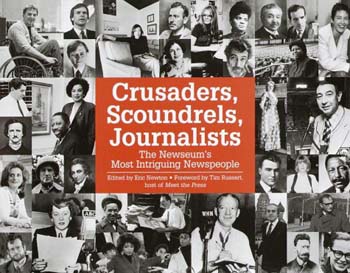![[MetroActive Books]](/books/gifs/books468.gif)
[ Books Index | Santa Cruz Week | MetroActive Central | Archives ]
Ink-Stained Tribute
The Newseum's collection honors crusaders, scoundrels and journalists
By John Yewell
ON A BLUFF overlooking the Potomac River, just across the Francis Scott Key Bridge from the Georgetown neighborhood of the District of Columbia, in Arlington, Va., sits the Newseum, the brainchild of USA Today founder Allen H. Neuharth. The association was the cause of some skepticism when the Newseum was opened in April 1997 by the Freedom Forum, but in that short time it has won wide praise.
It is a stunning achievement, with interactive displays, a history of news rooms and even a working TV studio (the day I visited, Robert MacNeil was inside the glass-enclosed space taping a panel discussion). The plaza memorial outside to reporters killed in the line of duty, with its view of the Washington Memorial in the distance, will move you to tears.
On the drawing boards from the beginning has been a book. Crusaders, Scoundrels, Journalists is a compendium of 285 people--not all of them journalists--who have had an impact on news--not all of it good. Editor Eric Newton--a Pulitzer Prize winner and former managing editor of the Oakland Tribune--borrowed the coinage "Newspeople" to describe his inclusions, dividing them into 16 categories, such as "Crusaders," "Sleuths," "Media Moguls" and "Martyrs."
If ever a book was too small at 399 pages, this is it. It's expansive and quixotic and full of stories one had either never heard or had forgotten. For those of us in the business, it's a reminder of why we got into it. For the public--which in a recent U.S. News & World Report poll on perceived cheating ranked journalists just behind politicians--it's an encyclopedia of reasons why the First Amendment is, well, first, and must be defended ferociously by somebody.
In a recent forum, Newton described "newspeople" as those who value things like accuracy, fairness, context and truth, and who take the time to verify and clarify. But Newton's real definition, which he mentioned at the same forum, is "anyone who affects the way you get news"--and in this is found the book's greatest failing. In lumping together the likes of Oprah Winfrey and Jerry Springer with Edward R. Murrow and Seymour Hersh, Newton creates a hopeless compromise guaranteed to satisfy no one and a disservice to the thousands of names on the plaza memorial.
MANY REPORTERS who did it best were left out altogether. The most surprising omissions, which deserve a 17th chapter, come from the alternative press. No book on American journalism can stake a true claim on the second half of the 20th century without discussing the contributions of the Village Voice, founded in 1955 by Norman Mailer and others and which has won two Pulitzer Prizes and a raft of other awards. Missing also are Warren Hinkle and Ramparts, and Paul Krassner's The Realist, groundbreaking publications that changed the way Americans thought about culture and politics in the '50s and '60s.
Newton could also have included a chapter on the obscure, unheralded men and women who fought for justice or simply left a colorful mark on the landscape. Where is Walter Liggett, the crusading Minneapolis editor, avowed socialist and persistent critic of so-called populist Farmer-Labor Gov. Floyd B. Olson of Minnesota, who was murdered by gangsters in 1935. Or Dan Anthony, the abolitionist Kansas editor and brother of Susan B. Anthony, who carried two large pistols wherever he went and had to use them more than once. Or John Clum, the Indian agent and publisher of the Tombstone Epitaph from 1880 to 1886, who later worked for the San Francisco Examiner.
But perhaps the most moving segment of the book is the chapter on "Martyrs." Here you can read about Don Bolles, the Arizona Republic reporter who was murdered in 1976 while investigating land fraud, and whose death led to an invasion of the state by dozens of journalists to finish what Bolles had started. Or Bill Stewart, the ABC news correspondent who was made to kneel down in a Managua, Nicaragua, street in 1979 and then murdered by Samoza's troops (although the book misidentifies the war as between government troops and Contras, instead of the Sandinistas).
For all its warts, Crusaders, Scoundrel, Journalists is worth a look, and on balance an interesting look at the history of news.
Copyright © Metro Publishing Inc. Maintained by Boulevards New Media.
![]()

Crusaders, Scoundrels, Journalists: The Newseum's Most Intriguing Newspeople
Edited by Eric Newton
Times Books; 399 pages; $35 cloth
From the March 1-8, 2000 issue of Metro Santa Cruz.